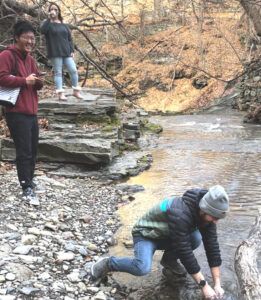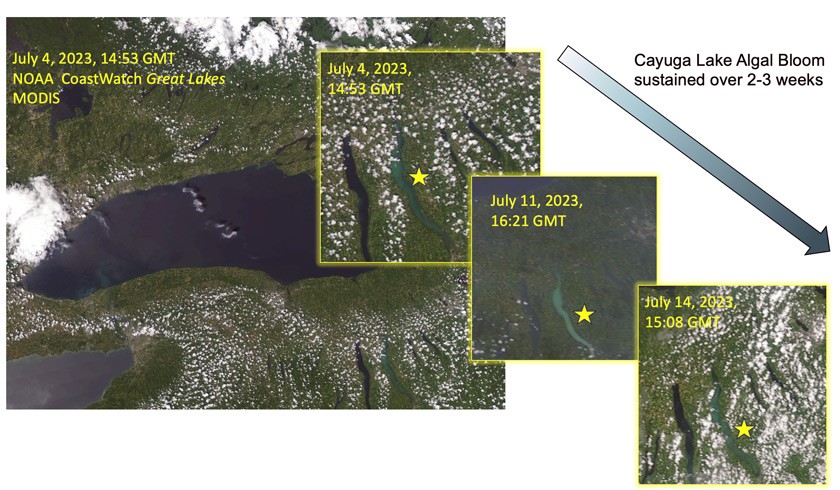Nicole Fernandez, an assistant professor in the Department of Earth and Atmospheric Sciences in the College of Engineering, just started her second year of teaching at Cornell.
Nicole and her students have been focusing on water and its movement through watersheds. Some of their most exciting work is happening in Cascadilla Gorge—just footsteps from their lab in Snee Hall. Nicole noticed that not many of her colleagues were studying local watersheds, so she and her students decided to monitor Cascadilla Creek.

For the past eighteen months, they’ve collected daily water samples to measure changes in the water chemistry in response to storms, drought, and other events. One of Nicole’s doctoral students, Hunter Jamison, expanded the effort to include rainwater collected from the roof of Snee Hall and from the Northeastern Regional Climate Center’s weather station on Game Farm Road.
The group continued monitoring the creek in June and July 2023—when record wildfires in Quebec produced dense clouds of smoke that blanketed Ithaca and a large part of the Northeast and mid-Atlantic US.
An unexpected result
Nicole recalls the moment when she and her team analyzed the water samples and saw something unexpected.
“To our surprise, we found notable spikes in the stream and rainwater phosphorus concentrations. They were three times higher than the annual average,” Nicole says, noting that phosphorus is a key nutrient for freshwater organisms. “This event coincided with what appeared to be an early onset of a lake-wide harmful algal bloom (HAB) in Cayuga Lake, which was visible by satellite.”
According to their data, phosphorus in the wildfire smoke (derived from burning trees) rapidly made its way into Cascadilla Creek water. As the phosphorus-rich water flowed into Cayuga Lake, it triggered HABs.
HABs have been increasing in frequency since 2014, when they were first spotted in Cayuga Lake. The blooms are caused by microcystin algae, which turns the water bright green or blue and can cause a range of health effects in people and animals when touched, swallowed, or inhaled. The blooms typically occur in late summer and are generally attributed to excess phosphorus or nitrogen in the water from agricultural run-off that flows into warm, slow-moving lake water. Most of this run-off comes from tributaries at the north end of the lake, where many agricultural activities are centered.

The NYS Department of Environmental Conservation has (so far) confirmed 47 HABs in Cayuga Lake this summer, including six blooms in June coinciding with the wildfire smoke event.
According to Nicole, the implications of her preliminary findings are profound and far-reaching:
“If wildfire smoke becomes more prevalent in the near future (which is likely), then our results indicate that southern tributaries in the Cayuga Lake watershed have the potential to substantially increase nutrient loading. Future wildfire smoke events could threaten the water quality of watersheds across the Finger Lakes, which serve as critical resources of drinking water for the community.”
Nicole and her students did not set out to study this phenomenon, but they happened to be in the right place at the right time to capture the rapid changes in water chemistry resulting from wildfire smoke. And their results changed everything—prompting Nicole and her students to home in to better understand their findings.
“We’ve seen elevated levels that have continued into August,” Nicole says, adding, “This is concerning.”
Next steps

Nicole doesn’t yet know how long the nutrient loading will persist and how it will impact the groundwater and the watershed as a whole. She’s working to secure grant funding for her team to follow up on their initial results and build new partnerships to collaborate in further scientific research.
One potential Cornell partner is Matthew Reid, an assistant professor of Civil and Environmental Engineering who studies mineral contaminants as they cycle through watersheds, for example: the trace amounts of metals like manganese, arsenic, and lead that are naturally stored in forests. Such minerals could become much more concentrated when millions of acres of forest burn (the Canadian Interagency Forest Fire Center estimates that more that 42 million acres have burned across Canada so far this year). Nicole and Matt hope to investigate these smoke-derived metal contaminants and their behavior in watersheds.
Nicole also hopes to launch a citizen-science partnership with the Community Science Institute (CSI), which works through an extensive volunteer network to monitor Cayuga Lake. She envisions partnering with CSI to coordinate rapid response water sampling during future wildfire smoke events, to get more comprehensive data on water quality impacts.
“I’m hoping by next summer, we can have things in place so that when a wildfire smoke event happens, people can just grab water samples. We can use CSI’s volunteer networks to better evaluate this, not just in one simple stream and watershed, but throughout the Finger Lakes,” she says.
Nicole plans to publish her group’s preliminary data on the Cayuga Lake watershed, with the hope that the article will open a conversation about the broader impacts of her results.
“People in this area, and in other areas of the world, might start thinking, ‘Hey, we’re downstream from smoke too,’ and maybe they can start collecting data as well.”
The ‘critical zone’

Nicole was attracted to the field of biogeochemistry because of its complexity. The study involves looking at layers that interact over multiple time scales: from rock, to soil, to water, to air.
“It’s almost like we have different fabrics of time,” she says. “We have soils that are recording 10,000-year timescales, water that’s percolating and reflecting today—or maybe 10 years ago, or 100 years ago—and plants that are taking up that soil and water right now.”
The interplay of these environmental layers with human society fascinates Nicole. She tries to encourage her students to think about their work holistically and draw upon geologic time scales to inform their understanding of current issues.
She leads a research team of four doctoral students and three undergraduates who call themselves the “CritChem” group. The students chose this name because they are looking at the “critical zone” of the Earth—the surface layer that ranges from the treetops into the groundwater.
This relatively narrow zone is where we source our groundwater and the vast majority of natural resources we depend on. The critical zone is impacted by climate change through sea level rise, intensifying storms, wildfires, etc., and it helps buffer the impacts of climate change through the absorption of carbon by rocks, soils, forests, and water.
“Changes here impact water quality, groundwater availability, and soil health. This zone is the source of all the critical metals that we mine, and, maybe most importantly, it is crucial to getting carbon out of our air and water,” Nicole explains.

As a teacher, Nicole’s goal is to consider anthropogenic impacts on the critical zone as another layer in the model. She hopes her students will consider the impacts that humans are having on the system as something that can be changed.
“We have to think about the ways we’re imprinting, or forcing, or making changes to our communities,” Nicole says, so that when her students go on to future positions they can say, “‘Okay, I know what we’re doing wrong and maybe we can find different ways to change that or adapt the way we’re doing things.’”
Note: Nicole Fernandez was a Provost’s New Faculty Fellow at Cornell for one year prior to starting her faculty position. She spent her fellowship year studying collaborative watershed management at the University of Bordeaux. “The Provost’s fellowship offered the space and flexibility to begin shaping the identity of my research group, open new lines of research, and become more interdisciplinary,” Nicole says. “I don’t believe I would have felt comfortable accepting a faculty position at Cornell without the mentorship and resources the fellowship provided.”


